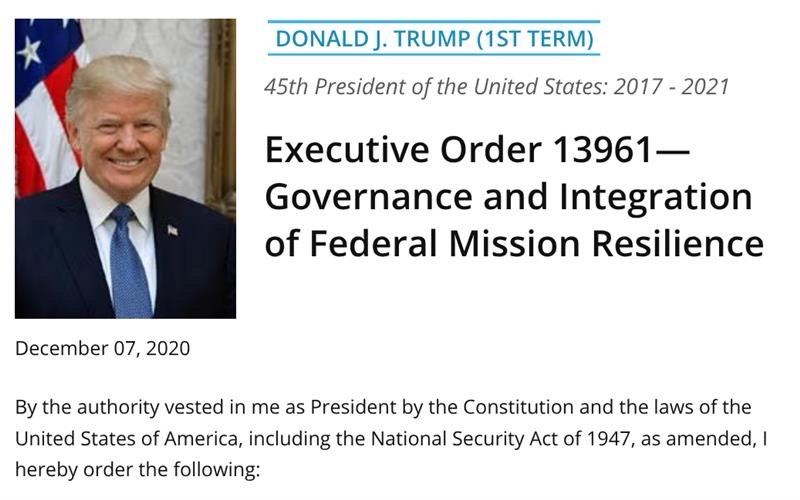The assertion that EO 13961 established a covert “wartime command structure” intended to circumvent the constitutional transfer of power and maintain the former President as the Commander in Chief throughout the subsequent administration is definitively false. This interpretation relies on a profound misreading of constitutional law and a conflation of administrative continuity planning with military command doctrine.
The most conclusive evidence against this conspiracy narrative lies in the subsequent executive actions. The incoming administration exercised its full, unimpaired constitutional authority by issuing Executive Order 14146 (Partial Revocation of Executive Order 13961) on January 19, 2025.3 This action successfully revoked the core governance structure established by EO 13961, replacing it with new mechanisms aligned with the successor administration’s National Security Memorandum.4 The smooth and legal transfer of executive control over this sensitive policy area validates that the constitutional transition of the Presidency was complete and unchallenged by the instruments within the order.4
EO 13961 contains no language, structure, or legal authority capable of superseding the constitutional mechanisms for presidential succession defined by the 20th and 25th Amendments.5 Furthermore, the order explicitly contains a savings clause stating that it does not create any enforceable right or benefit, substantive or procedural, against the United States.1 This critically important detail negates any possibility of the order serving as the legal basis for a separate, covert command authority.
II. The Foundational Framework of Continuity of Government (COG) Policy
The context for understanding Executive Order 13961 requires a thorough examination of the long-standing policies governing federal continuity planning. COG is not a niche or novel concept invented for political maneuvering; it is a mature, necessary administrative function.
Historical Development and Scope of COG
The principle of continuity of government first gained prominence in the United States during World War II and was significantly formalized throughout the Cold War era. The initial focus of COG planning was primarily the prevention of catastrophic disorder following a nuclear attack, ensuring that the federal government could maintain operations despite severe decapitation or destruction of infrastructure.2
Following the September 11, 2001, terrorist attacks, the scope of COG policy expanded dramatically. Continuity of Operations (COOP) and COG planning were activated in response to a non-nuclear domestic incident, demonstrating that the policy is now viewed as an essential component of routine domestic crisis management and disaster preparedness, covering a wide range of catastrophic events that threaten essential services.2 This history firmly establishes continuity planning as a civil administrative function coordinated through emergency management structures, not exclusively a military function.
Defining the Instruments of Continuity
Federal continuity capabilities are defined by a tripartite structure:
- Continuity of Operations (COOP): Focuses on the internal planning carried out by individual executive departments and agencies to ensure they can maintain their specific mission-essential functions during disruptions.
- Continuity of Government (COG): The high-level strategic process ensuring that the fundamental institutions of the government—including the three branches—can survive and function legally during and after a catastrophic event.
- Enduring Constitutional Government (ECG): The overarching goal, which ensures the resilience and preservation of the government structure under the United States Constitution and the maintenance of constitutional processes.7
The goal of ECG is paramount: to preserve the separation of powers and civil liberties even under duress. This requirement is diametrically opposed to the creation of an autocratic or military “command structure” designed to usurp civilian authority.
Presidential Policy Directive 40 (PPD-40): The National Continuity Policy
The primary policy mandate guiding all federal continuity planning is Presidential Policy Directive-40 (PPD-40), issued in July 2016. EO 13961 explicitly states its policy is “in alignment with Presidential Policy Directive-40”.1 PPD-40 establishes that the United States must maintain a comprehensive and effective continuity capability.7
Under PPD-40, the responsibility for coordinating continuity activities across the executive branch rests with the Secretary of Homeland Security, primarily through the Administrator of the Federal Emergency Management Agency (FEMA).7 FEMA is directed to develop and promulgate Federal Continuity Directives (FCDs) to set planning requirements for all departments and agencies (D/As).7 The fact that the entire system is coordinated by FEMA, a civil agency focused on domestic disaster and emergency management, reinforces that this policy framework is fundamentally administrative and rooted in bureaucratic procedure, not a mechanism for military control. The administrative mandate of EO 13961 was thus not a novel or radical concept, but rather an attempt to refine the governance and implementation of an existing bureaucratic framework established four years earlier.
The Centrality of National Essential Functions (NEFs)
All continuity programs, including EO 13961, focus on the continuous performance of National Essential Functions (NEFs).7 These are the eight overarching responsibilities the Federal Government must maintain under all conditions, serving as the definitive measure of operational resilience.
The nature of the NEFs demonstrates the broad civil application of continuity policy, further debunking the theory that EO 13961 is solely military in nature.
|
NEF Number
|
Description of National Essential Function
|
|
NEF 1
|
Ensuring the continued functioning of our form of government under the US Constitution, including the functioning of the three separate branches of government.
|
|
NEF 2
|
Providing leadership visible to the Nation and the world and maintaining the trust and confidence of the American people.
|
|
NEF 3
|
Defending the United States against all enemies, foreign and domestic, and preventing or interdicting attacks.
|
|
NEF 4
|
Maintaining and fostering effective relationships with foreign nations.
|
|
NEF 5
|
Protecting against threats to the homeland and bringing perpetrators of crimes to justice.
|
|
NEF 6
|
Providing rapid and effective response to and recovery from the domestic consequences of an attack or other incident.
|
|
NEF 7
|
Protecting and stabilizing the Nation’s economy and ensuring public confidence in its financial systems.
|
|
NEF 8
|
Providing for Federal Government services that address the national health, safety, and welfare needs of the United States.
|
As shown in the table above, the NEFs cover functions such as stabilizing the economy (NEF 7) and addressing national health and welfare (NEF 8).9 Crucially, NEF 1 mandates the preservation of the constitutional structure, including the functioning of the legislative, judicial, and executive branches. If EO 13961 were intended to usurp the authority of the incoming President, it would directly violate the most fundamental NEF it was designed to support. The focus is overwhelmingly on routine governmental functions required for civil stability, placing the order firmly in the realm of bureaucratic procedure rather than military takeover.
III. Analysis of Executive Order 13961: Governance and Integration of Federal Mission Resilience
Executive Order 13961 (EO 13961) was signed on December 7, 2020.1 Its issuance date, weeks after the 2020 presidential election, places it within the timeline of a standard late-term administration effort to finalize or codify internal management policy before a transition.
Context and Policy Mandate
The title, “Governance and Integration of Federal Mission Resilience,” emphasizes its function as an instrument of management oversight, specifically focusing on coordinating the efforts of various executive departments and agencies.1 The core policy mandate (Original Section 1) required all executive departments and agencies (D/As), including the Executive Office of the President, to maintain the operational capacity needed to continuously perform the NEFs.1 This mandate is directed at agency heads and civil servants, instructing them to maintain specific levels of resilience, such as maintaining secure communications, essential payroll, and critical databases.
The concept of “resilience” in this policy context relates to the administrative ability to absorb catastrophic shocks and quickly restore operational capacity. This includes standard administrative requirements such as submitting plans, conducting readiness exercises, and ensuring data security. This operational focus is dramatically different from a “wartime command,” which typically involves extraordinary legal powers, suspension of civil procedure, and command authority derived from military law.
Structural Mechanisms and Bureaucratic Requirements
To execute this policy, EO 13961 established an Executive Committee (Original Section 3).1 The committee was tasked with detailed administrative oversight. Within 90 days of the order’s issuance, this Executive Committee was required to submit a Federal Mission Resilience Executive Committee Charter and a detailed Federal Mission Resilience Implementation Plan to the President through the Chief of Staff.1 Furthermore, the committee was mandated to coordinate the review of existing continuity policies and provide recommendations to the President on necessary actions within 120 days.1
These requirements—submission of charters, detailed implementation plans, and policy coordination reviews—are the hallmarks of bureaucratic governance, not a military command structure. They were designed to standardize and measure the administrative performance of continuity planning across the executive branch, confirming the order’s identity as a procedural management directive.
Legal Limitations: The Non-Enforceability Clause
A key provision that legally isolates EO 13961 from the constitutional crisis narrative is the presence of a non-enforceability or “savings” clause (Original Section 8, renumbered Section 3).4
This section explicitly states: “This order is not intended to, and does not, create any right or benefit, substantive or procedural, enforceable at law or in equity by any party against the United States, its departments, agencies, or entities, its officers, employees, or agents, or any other person”.1 This clause confirms the order is purely internal guidance for the executive branch. It prohibits any outside entity, or even any internal party, from using the order as a legal basis to enforce a claim or challenge a decision in court. Had the order been intended to function as a powerful, autonomous “wartime command structure,” it would need to grant specific, enforceable legal authorities; the non-enforceability clause renders any such claim legally null.
IV. Legal Status and Subsequent Modifications: The Definitive Debunking
The ultimate legal fate and current application of EO 13961 decisively refute the conspiracy theory that it created an enduring power structure outside of the normal constitutional transfer.
The Constitutional Authority of Executive Orders
Under the U.S. system of government, an Executive Order is an instrument for managing the executive branch. It does not carry the weight of statutory law and is subject to revocation, rescission, or modification by any succeeding President who holds the constitutional authority of the executive office.
Partial Revocation by the Successor Administration
The successor President, upon assuming office, demonstrated the full extent of the constitutional transfer of power by taking specific action to modify EO 13961. On January 19, 2025, Executive Order 14146, titled “Partial Revocation of Executive Order 13961,” was issued.3
This executive action was comprehensive:
- Revoked Sections: Sections 1 (Policy), 3 (Executive Committee establishment), 4 (Implementation Plan requirements), 5 (National Continuity Coordinator duties), and 7 (Definitions) of EO 13961 were explicitly revoked.4
- Renumbered Sections: Only three sections—Original Sections 2, 6, and 8—were retained and renumbered as Sections 1, 2, and 3, respectively.4
The immediate revocation of the entire administrative governance structure (specifically Section 3, which established the Executive Committee) proves that the transfer of executive control was complete and legitimate. If EO 13961 had established a hidden mechanism for the former President to retain authority (a “command structure”), that structure would have necessarily prevented or challenged its own legal dismantling by the subsequent President. The successful execution of EO 14146 serves as irrefutable legal proof that no such parallel command structure existed.
Policy Transition and Replacement Structures
The successor administration did not simply eliminate continuity planning; it integrated the core requirements into its own governing architecture. The primary administrative body established by EO 13961—the Executive Committee—was eliminated. The duties related to mission resilience governance were formally transferred to the Restricted Principals Committee, a new structure detailed in the subsequent National Security Memorandum (NSM) of January 19, 2025 (National Continuity Policy).4
The remaining sections of EO 13961, as renumbered, primarily retain the general responsibilities of agency heads (Original Section 2, now Section 1) and the critical non-enforceability savings clause (Original Section 8, now Section 3).4 This transition demonstrates a routine governmental process: one administration’s management policy was replaced by the next administration’s preferred management structure, fully utilizing the constitutional authority vested in the succeeding President.12
The table below illustrates the precise administrative changes effected by the Partial Revocation:
Table 2: Status and Amendments to Executive Order 13961 (2020-Present)
|
Original Section of EO 13961
|
Topic/Mandate
|
Current Status (Post-EO 14146, Jan. 2025)
|
Significance of Change
|
|
Section 1
|
Policy statement requiring continuity programs.
|
Revoked.4
|
Policy statement superseded by new National Security Memorandum (NSM).
|
|
Section 2 (Renumbered 1)
|
Roles and Responsibilities of Heads of Agencies.
|
Renumbered and Amended.4
|
Amended to replace reference to old “Executive Committee” with new “Restricted Principals Committee”.4
|
|
Section 3
|
Establishment of the Executive Committee.
|
Revoked.4
|
The central administrative governance structure was eliminated.
|
|
Section 4
|
Submission of Federal Mission Resilience Charter and Implementation Plan.
|
Revoked.4
|
Specific planning directives under the old structure were canceled.
|
|
Section 5
|
Duties of the National Continuity Coordinator.
|
Revoked.4
|
Coordinator duties redefined under the new policy framework.
|
|
Section 6 (Renumbered 2)
|
General Provisions (e.g., direction to publish orders).
|
Renumbered and Retained.4
|
Standard administrative retention.
|
|
Section 7
|
Definitions.
|
Revoked.4
|
Definitions likely absorbed or updated by the new NSM.
|
|
Section 8 (Renumbered 3)
|
Savings Clause (Non-enforceability).
|
Renumbered and Retained.4
|
Confirms continued administrative, non-enforceable nature.1
|
V. Constitutional Law and The Debunking of the “Wartime Command” Narrative
The conspiracy narrative surrounding EO 13961 fails primarily due to a fundamental lack of understanding regarding the mechanisms of constitutional power transfer in the United States. Presidential succession and administrative continuity are legally distinct fields.
The Primacy of Constitutional Succession
The transfer of presidential power is governed exclusively by the Constitution, specifically the 20th and 25th Amendments, and the Presidential Succession Act of 1947.5 These constitutional provisions dictate who holds the office, how a vacancy is filled, and the procedures for a temporary transfer of power (inability).13 An Executive Order, which is merely a directive for internal executive branch management, possesses no legal authority to alter or supersede these constitutional and statutory mandates.
The following comparison illustrates the legal separation between these two concepts:
Table 1: Comparison of Constitutional Presidential Succession vs. Administrative Continuity of Government (COG)
|
Feature
|
Constitutional Succession (25th Amendment)
|
Administrative COG (PPD-40/EO 13961)
|
|
Purpose
|
Transferring the Office and Constitutional Authority of the Presidency/Vice Presidency.
|
Ensuring the Functions and Operations of Federal Agencies persist during crises.
|
|
Legal Basis
|
U.S. Constitution, 25th Amendment, Presidential Succession Act of 1947.5
|
Presidential Policy Directives (PPD-40), Federal Continuity Directives, and Executive Orders.[1, 7]
|
|
Trigger
|
Death, resignation, removal, or declared inability of the President.5
|
Catastrophic events (natural disasters, attacks, infrastructure failure).2
|
|
Authority Focus
|
Legal and political legitimacy of the office holder.
|
Operational resilience and technical capacity.
|
|
Affected Entities
|
The President, Vice President, and statutory line of succession.
|
All Executive Departments and Agencies (D/As) and the Executive Office of the President.1
|
The legal framework is clear: EO 13961 operates on the technical and operational plane, ensuring systems resilience. It has no mechanism, implicit or explicit, to influence the process by which constitutional authority transfers from one President to the next.
Refuting the Military Command Interpretation
The claim that EO 13961 establishes a “wartime command structure” misrepresents the entire policy tradition of COG. The explicit primary goal of Enduring Constitutional Government (ECG), which EO 13961 supports, is the continuous performance of NEF 1: “Ensuring the continued functioning of our form of government under the United States Constitution, including the functioning of the three separate branches of government”.9
A structure designed to install a shadow or permanent command authority contrary to the election results would inherently violate this fundamental NEF. The established purpose of COG is to protect constitutional governance from catastrophic failure and usurpation, not to facilitate it. Interpreting this protective mechanism as a tool for seizing power is a profound conceptual error.
Semantic Misappropriation: COG vs. Schwerpunkt
The propagation of this theory is likely aided by a critical linguistic confusion arising from the use of the acronym COG. In the context of national security and emergency planning, COG stands for Continuity of Government.2 However, in military planning, the abbreviation COG often refers to Center of Gravity (Schwerpunkt), a strategic concept derived from Carl von Clausewitz’s theories of war.14
The “Center of Gravity” theory, which military planners debate and apply to link objectives to courses of action, carries a weight and operational severity far removed from administrative continuity.15 Conspiracists appear to commit a category error, using the operational and military gravity associated with the strategic “Center of Gravity” to falsely ascribe secret military control to the administrative planning document titled “Continuity of Government.” The focus of EO 13961 on bureaucratic instruments such as implementation plans and interagency charters confirms its administrative identity, entirely separate from military operational command structures.1
VI. Conclusion: Administrative Policy and the Problem of Misinformation
Executive Order 13961 was a standard administrative directive, signed late in an administration, intended to reorganize and refocus internal continuity governance efforts within the executive branch. Its purpose was to optimize compliance with long-established federal policy (PPD-40) aimed at ensuring the nation’s ability to perform its most essential civil, economic, and defensive functions during a crisis.1
The narrative claiming that EO 13961 established a “wartime command structure” or otherwise allowed the former President to retain executive authority throughout the subsequent administration is definitively baseless. The constitutional transfer of power was fully completed, demonstrated by the successor President’s successful and routine exercise of executive authority to partially revoke, amend, and replace the structural elements of EO 13961 via Executive Order 14146.3
The complexity and technical nature of national continuity policy, coupled with the sensitive need for secrecy regarding specific implementation plans (to prevent their exploitation by adversaries), unfortunately creates fertile ground for misunderstanding and the proliferation of misinformation. When technical acronyms (COG) and legal doctrines (Continuity of Government) are divorced from their established context and conflated with military concepts, the result is a spurious interpretation that undermines public confidence in the legal and constitutional stability of the United States government. The legal record confirms that EO 13961 was merely a matter of administrative organization, entirely subject to the legitimate and full authority of the sitting President.
References and Citations
- Executive Order 13961—Governance and Integration of Federal Mission Resilience, accessed October 31, 2025, https://www.presidency.ucsb.edu/documents/executive-order-13961-governance-and-integration-federal-mission-resilience
- Continuity of government – Wikipedia, accessed October 31, 2025, https://en.wikipedia.org/wiki/Continuity_of_government
- 2025 – Federal Register :: Executive Orders, accessed October 31, 2025, https://www.federalregister.gov/presidential-documents/executive-orders/joe-biden/2025
- Executive Order on the Partial Revocation of Executive Order 13961 …, accessed October 31, 2025, https://bidenwhitehouse.archives.gov/briefing-room/presidential-actions/2025/01/19/executive-order-on-the-partial-revocation-of-executive-order-13961/
- Order of presidential succession | USAGov, accessed October 31, 2025, https://www.usa.gov/presidential-succession
- Twenty-fifth Amendment to the United States Constitution – Wikipedia, accessed October 31, 2025, https://en.wikipedia.org/wiki/Twenty-fifth_Amendment_to_the_United_States_Constitution
- Federal Continuity Directive 1 Federal Executive Branch National Continuity Program and Requirements – U.S. Government Publishing Office (GPO), accessed October 31, 2025, https://www.gpo.gov/docs/default-source/accessibility-privacy-coop-files/January2017FCD1-2.pdf
- Continuity Resources | FEMA.gov, accessed October 31, 2025, https://www.fema.gov/emergency-managers/national-preparedness/continuity/documents
- Federal Continuity Directive 2: Federal Executive Branch Mission Essential Functions and Candidate Primary Mission Essential Fun – FEMA, accessed October 31, 2025, https://www.fema.gov/sites/default/files/2020-07/Federal_Continuity_Directive-2_June132017.pdf
- DCPD-202000879 – Executive Order 13961-Governance and Integration of Federal Mission Resilience – Content Details – – GovInfo, accessed October 31, 2025, https://www.govinfo.gov/app/details/DCPD-202000879
- Presidential Documents – GovInfo, accessed October 31, 2025, https://www.govinfo.gov/content/pkg/FR-2025-03-21/pdf/2025-04973.pdf
- Organization of the National Security Council and Subcommittees – The White House, accessed October 31, 2025, https://www.whitehouse.gov/presidential-actions/2025/01/organization-of-the-national-security-council-and-subcommittees/
- Presidential Succession and Inability: Before and After the Twenty-Fifth Amendment – The Fordham Law Archive of Scholarship and History, accessed October 31, 2025, https://ir.lawnet.fordham.edu/cgi/viewcontent.cgi?article=4695&context=flr
- Addressing the Fog of COG – Army University Press, accessed October 31, 2025, https://www.armyupress.army.mil/Portals/7/combat-studies-institute/csi-books/COG.pdf
- The Primacy of COG in Planning – NDU Press, accessed October 31, 2025, https://ndupress.ndu.edu/Portals/68/Documents/jfq/jfq-82/jfq-82_91-97_Kornatz.pdf







![[GOOD PRESS] ON[GOOD PRESS] ON](https://georgemagazine.com/wp-content/uploads/2024/08/16389056566437433941_2048-300x300.jpeg)


